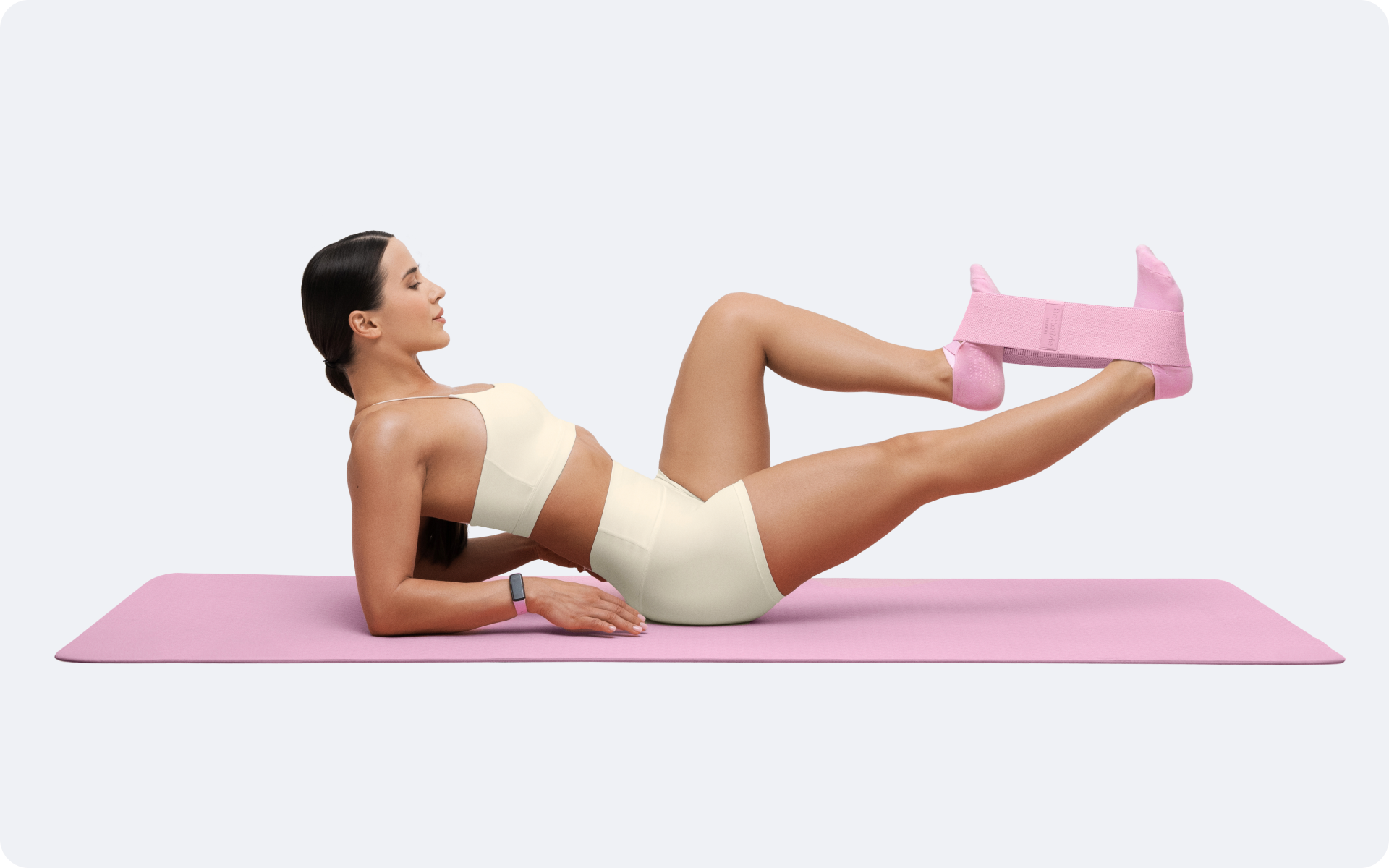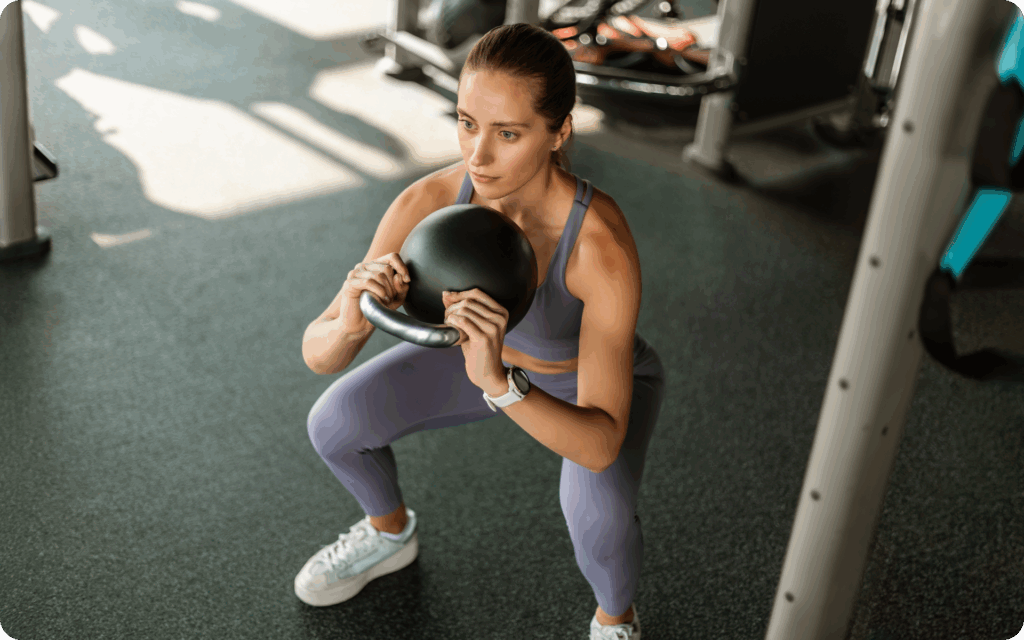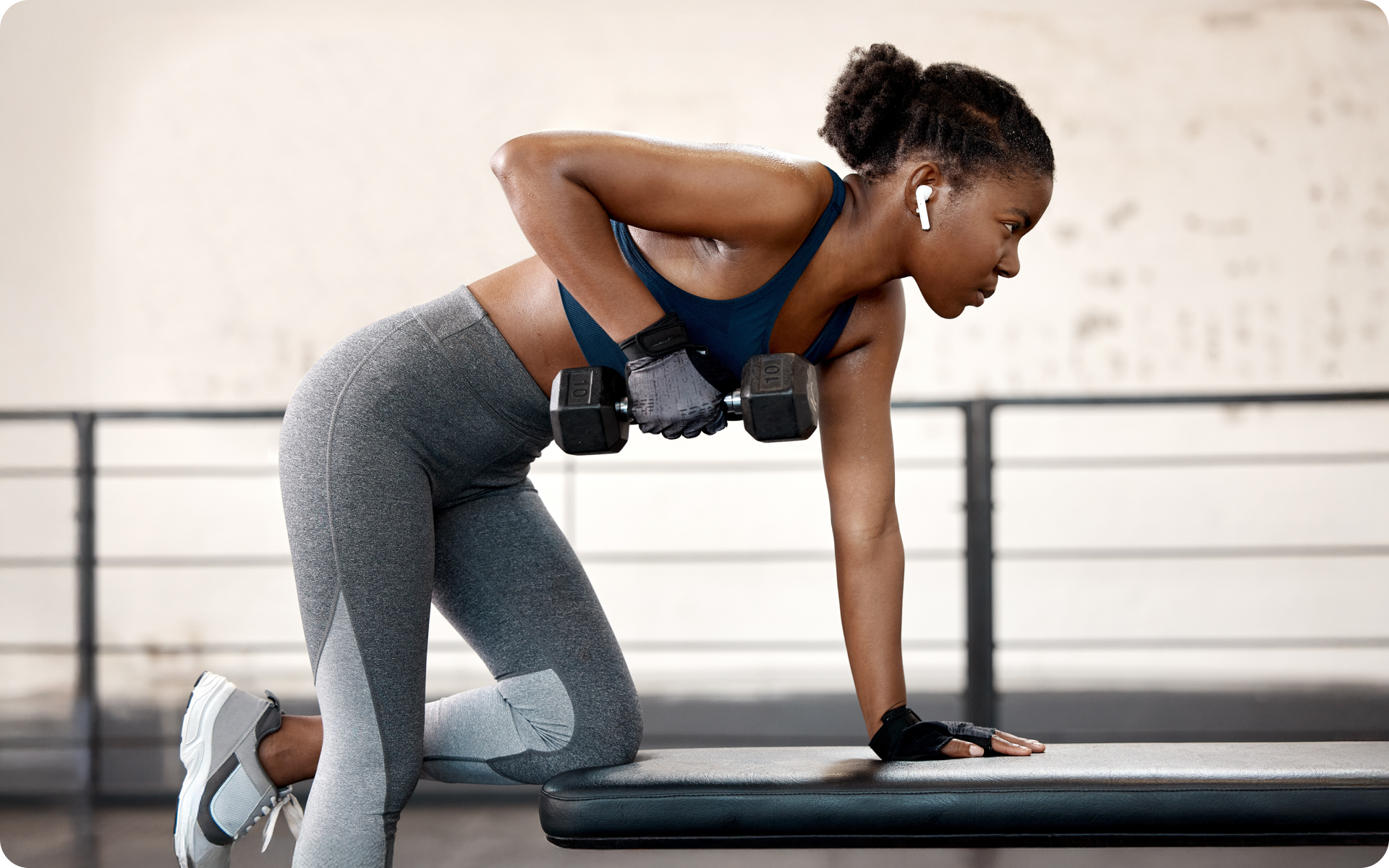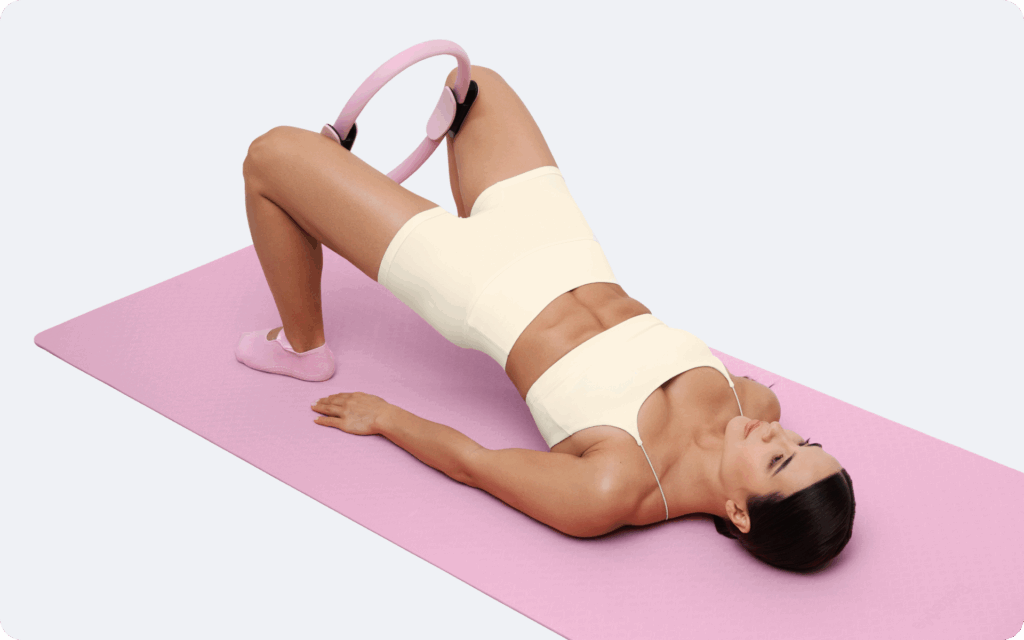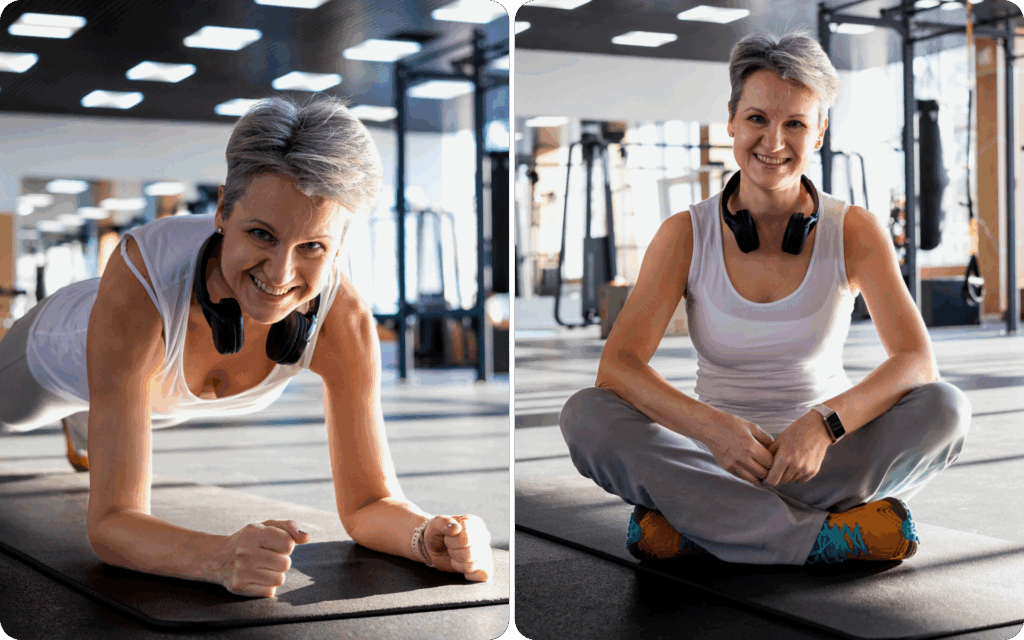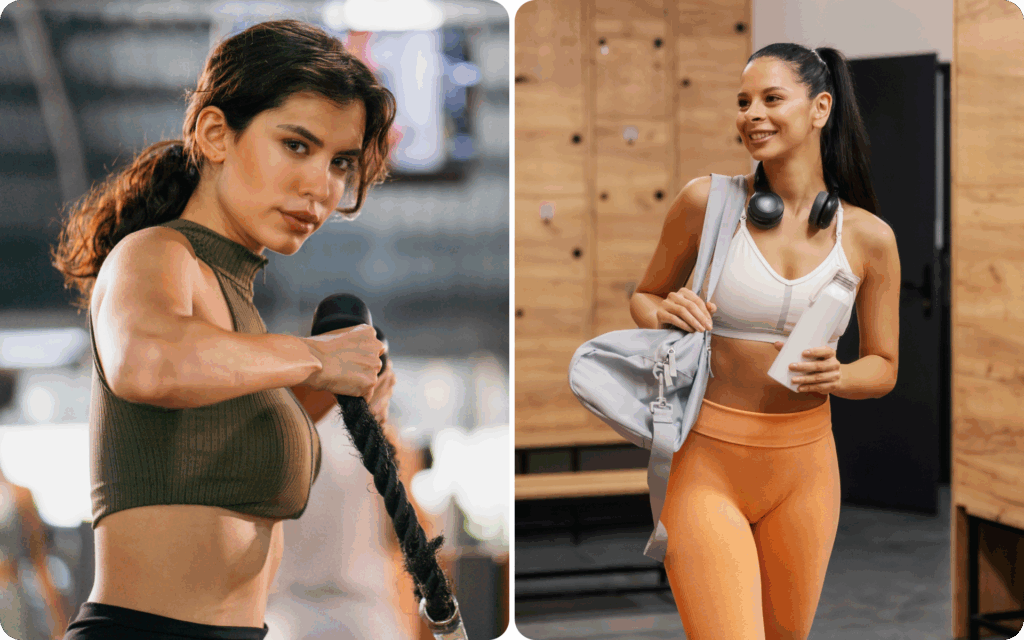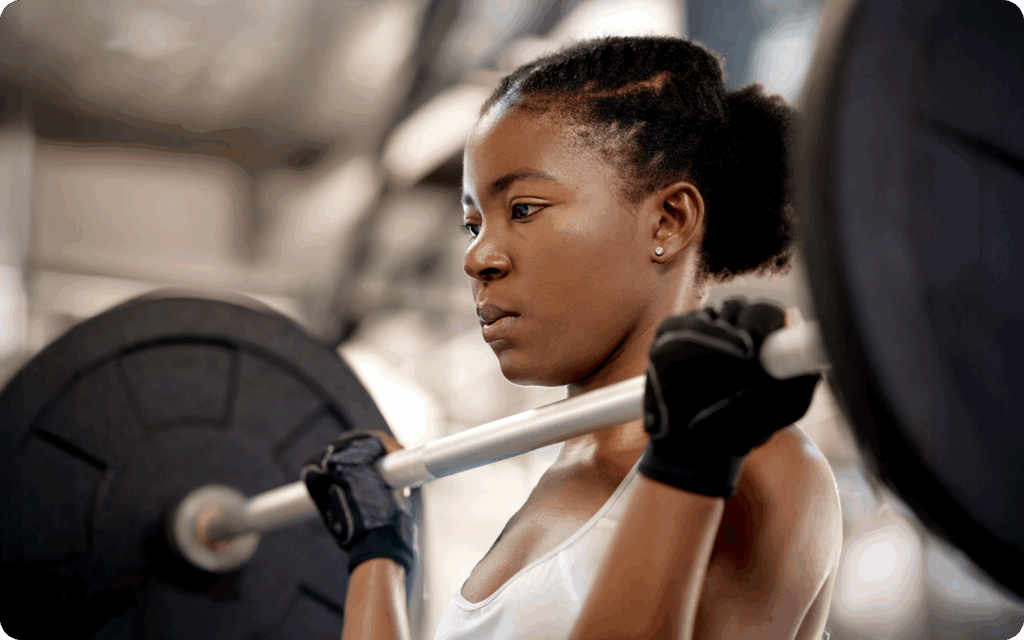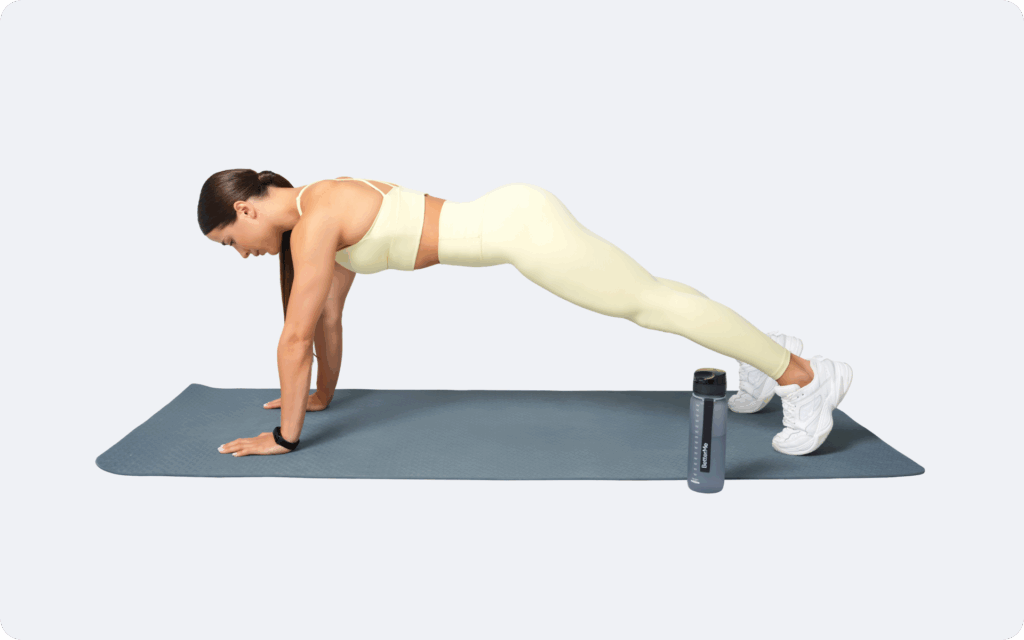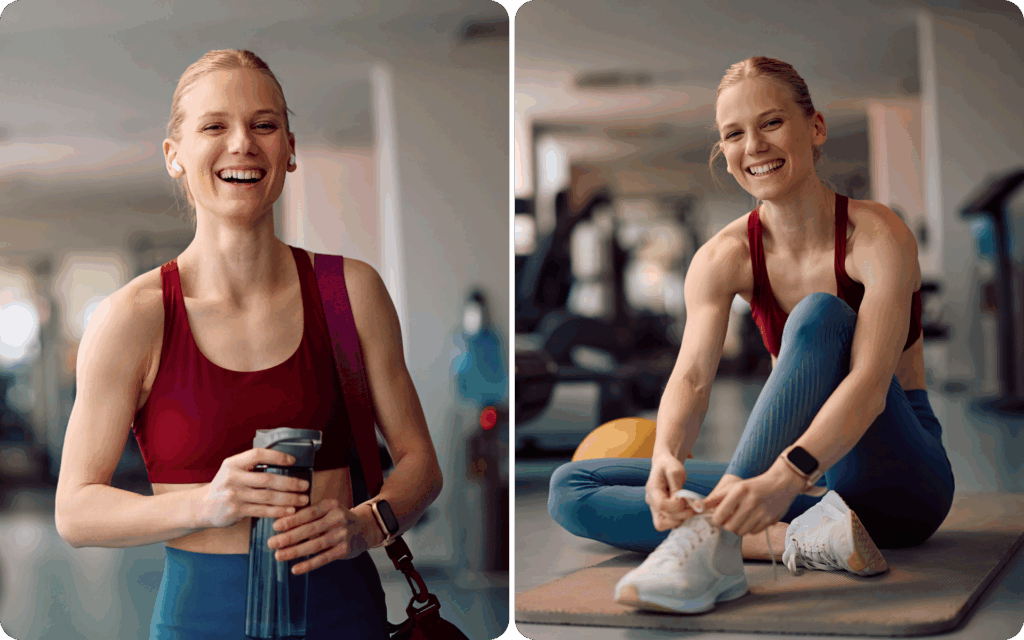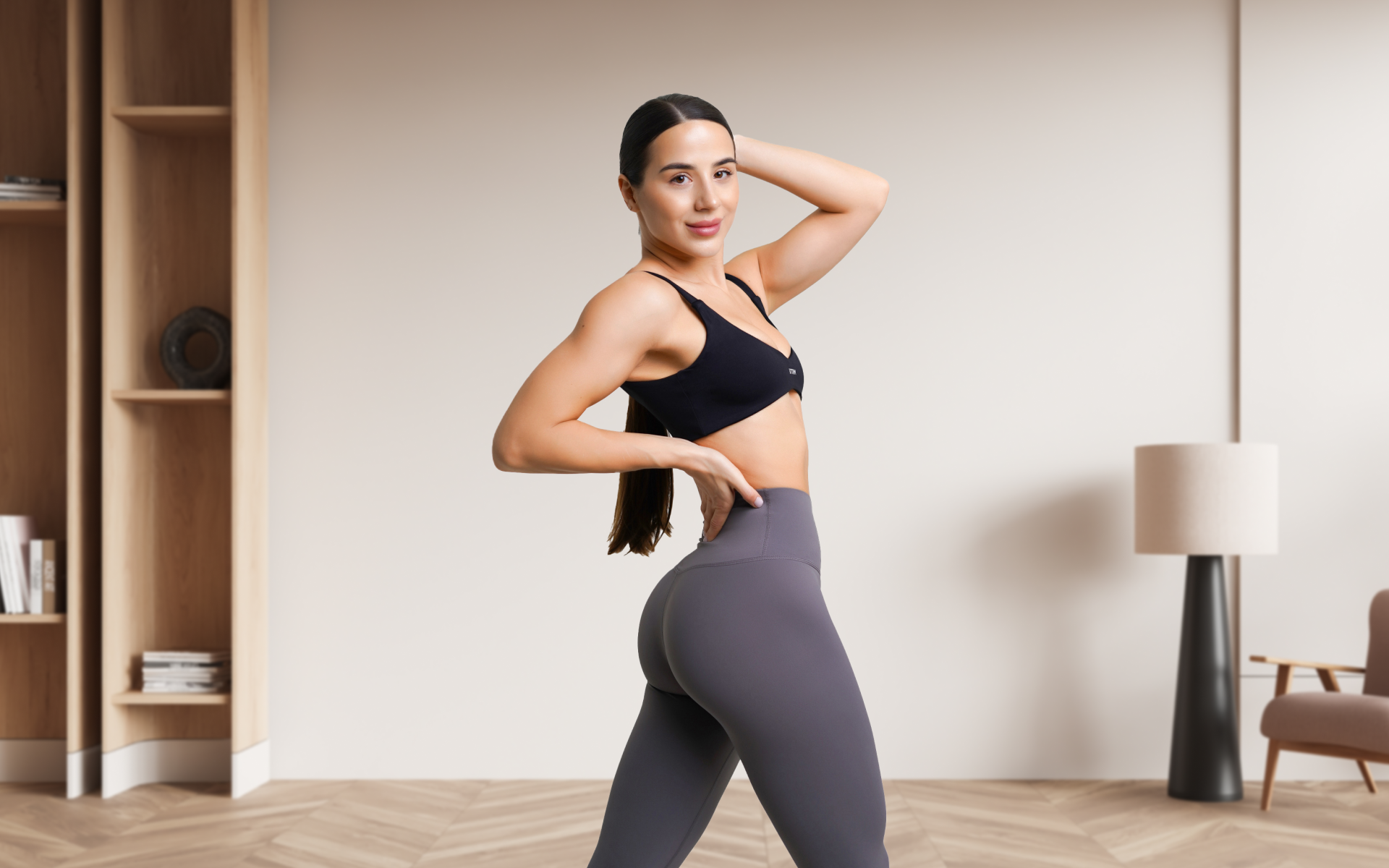If you’ve spent time scrolling through fitness content, you’ve probably noticed the term “functional training” being thrown around quite a bit. Maybe you’ve seen athletes hopping over hurdles, trainers cueing stability drills on balance pads, or older adults practicing sit-to-stand progressions. But what does it all actually mean – and more importantly, how can you put it into practice?
Functional training isn’t some trendy workout fad reserved for elite athletes or physical therapy clinics. It’s a purposeful approach to movement that helps you perform better in the activities that matter the most to you, whether that’s sprinting on a soccer field, lifting groceries without back pain, or simply moving through your day with more ease and confidence.
This guide will break down what functional training really is, walk you through the major exercise categories, and show you how to design your own beginner-friendly functional training workout plan.
What Are Functional Training Exercises?
Functional training, by design, is a training intervention that helps you function better – whether in everyday life or in competition. It’s not a special genre of training that’s reserved for a particular crowd. Instead, it’s intelligent, purposeful training that is meant to restore movement quality, improve performance, and reduce the likelihood of injury (1).
The key distinction? Functional exercise selection isn’t based on aesthetic outcomes such as bigger biceps or sculpted abs. Instead, it focuses on the carryover to your health and performance in real-world scenarios.
This means prioritizing movements that stress your body in all major movement patterns and across all three planes of motion: sagittal (forward and backward), frontal (side to side), and transverse (rotational) (2).
A 2024 systematic review of 32 trials found strong evidence that single-component functional training – practicing everyday tasks such as sit-to-stand progressions, stair negotiation, and reaching with rotation – improves or maintains activities of daily living (ADLs) in older adults (3).
For those with mild cognitive impairment, task-based functional exercise that simultaneously challenges movement sequencing and executive function showed consistent improvements in ADLs and cognition (3).
Even in athletic populations, a 2024 preprint meta-analysis across 67 randomized controlled trials reported that functional training yields moderate-to-large gains in maximal strength, power, and muscular endurance (4). While this study is still awaiting peer review, the trend is clear: functional training delivers measurable results across diverse populations.
So what types of exercises fall under the functional training umbrella? Let’s break them down by category.
Mobility
Mobility exercises focus on improving tissue extensibility and warming up the joints before high-intensity activity. These drills target areas that frequently exhibit excessive stiffness, such as the ankles, hips, thoracic spine, and shoulders (glenohumeral joint) (5).
Why it matters: Limited mobility restricts your ability to move efficiently and can lead to compensatory patterns that increase injury risk (6).
Exercise examples:
- 90/90 hip stretch
- Spiderman stretch
- Straight-leg adductor rocking
- Half-kneeling hip flexor stretch
- Wall quad stretch
- Ankle dorsiflexion
- Shoulder-controlled articular rotation
Intense sweat sessions, working weight loss tips, lip-smacking recipes come in one package with the BetterMe: Health Coaching app—all at your fingertips, start transforming your life now!
Motor Control
Motor control drills activate local stabilizing muscles to improve neurological efficiency and movement quality. These exercises help your body create authentic stability and prepare you for more demanding tasks (7).
Why it matters: Strong motor control means your nervous system can coordinate muscle activation patterns effectively, which translates to better performance and safer movement (7).
Exercise examples:
- Supine diaphragmatic breathing
- Floor slide
- Leg lower with band stabilization
- Quadruped hip extension from elbows
- Supine band hip flexion
Plyometric and Medicine Ball Exercises
Plyometrics involve high-speed, neurologically demanding movements such as hopping, jumping, and throwing. These exercises train your body to generate and absorb force quickly (8).
Why it matters: Plyometric training enhances power, explosiveness, and reactive strength – qualities essential for sports performance and injury prevention (8).
Exercise examples:
- Hurdle jump
- 45-degree bound
- Single-leg hurdle hop
- Explosive step-ups
- Overhead medicine ball throw
- Standing medicine ball side toss
- Standing medicine ball chest pass
- Rotational one-arm chest pass
Heavy Implement Power Exercises
These movements involve explosive lifting with implements such as barbells, kettlebells, and dumbbells. They bridge the gap between speed-based plyometrics and strength-focused resistance training (9)
Why it matters: Heavy implement power exercises develop total-body coordination, force production, and the ability to move loads quickly – key for athletic performance (9).
Exercise examples:
- Barbell hang clean
- Kettlebell swing
- Dumbbell snatch
- Sled march
Strength: Upper-Body Push
Upper-body pushing exercises target the chest, shoulders, and triceps. They develop pressing strength in multiple planes of motion (10).
Why it matters: Pushing strength is essential for tasks that range from pressing objects overhead to stabilizing your body during complex movements (10).
Exercise examples:
- Push-up
- Half-kneeling alternating kettlebell overhead press
- Barbell bench press
- Incline dumbbell bench press
Strength: Upper-Body Pull
Upper-body pulling exercises target the back, shoulders, and biceps. They help you open doors and allow you to develop the posterior chain of the upper body (11).
Why it matters: Pulling strength supports posture, shoulder health, and overall upper-body function (11).
Exercise examples:
- Chin-up
- Dumbbell row
- Inverted row
Strength: Hip Dominant
Hip-dominant exercises emphasize movements at the hip joint, targeting the glutes, hamstrings, and lower back.
Why it matters: Hip-dominant strength is essential for sprinting, jumping, lifting, and protecting your lower back from injury (12).
Exercise examples:
- Deadlift variations
- Glute Bridge
- Hip thrust
Strength: Knee Dominant
Knee-dominant exercises emphasize movements at the knee joint, targeting the quadriceps and surrounding stabilizers.
Why it matters: Knee-dominant strength supports activities such as squatting, climbing stairs, and decelerating during sports (13)
Exercise examples:
- Goblet squat
- Rear foot elevated split squat
- Single-leg squat
- Goblet loaded lateral squat
Core: Anti-Extension
Anti-extension exercises train the muscles that resist sagittal plane spinal movement (preventing excessive arching of the lower back).
Why it matters: Anti-extension strength protects your spine during loaded movements and improves the transfer of force between your upper and lower body (14)
Exercise examples:
- Front plank
- Ball rollout
- Dead bug
Core: Anti-Rotation
Anti-rotation exercises train the muscles that resist transverse plane spinal movement (preventing unwanted twisting).
Why it matters: Rotational stability is essential for athletic performance and everyday tasks that involve turning or reaching (15).
Exercise examples:
- Pallof press
- Single-arm farmer’s carry
Core: Anti-Lateral Flexion
Anti-lateral flexion exercises train the muscles that resist frontal plane spinal movement (preventing side bending).
Why it matters: Lateral stability supports single-leg movements, changes of direction, and overall postural control (16).
Exercise examples:
- Side plank
- Suitcase carry
Core: Anti-Flexion
Anti-flexion exercises train the muscles that resist forward spinal bending.
Why it matters: Anti-flexion strength protects your spine during lifting and helps maintain neutral posture under load (17).
Exercise examples:
- Back extension
- Good morning
Do you want to dive deeper into the science behind strength development? Check out our guide to functional strength training.
Read more: What Is Hybrid Calisthenics? Here’s How to Integrate Bodyweight Training with Weight Training
How to Design a Functional Workout
Now that you understand the exercise categories, let’s talk about how to put them together into a cohesive program. A well-designed functional training program develops joint mobility, motor control, strength, and power across all three planes of movement. Here’s how to structure it:
Start With Mobility Work
Start every session with mobility drills. Active stretching and articular rotations improve tissue extensibility and warm up the joints before high-intensity activity. Focus on the ankles, hips, thoracic spine, and shoulders – these areas tend to get stiff and limit movement quality.
How to implement:
- Choose 3-5 mobility drills that target your specific needs.
- Perform each drill for 30-60 seconds or 8-10 reps per side.
- Move through the drills in a smooth, controlled manner.
- Progress gradually by increasing range of motion or adding light resistance.
Layer In Motor Control
After mobility work, progress to motor control and movement preparation drills. These exercises activate local stabilizing muscles and improve neurological efficiency, laying the foundation for higher-intensity work.
How to implement:
- Select 2-4 motor control exercises.
- Perform 2 sets of 8-12 reps per exercise.
- Focus on quality over speed – these drills are about precision.
- Incorporate breathing cues (such as diaphragmatic breathing) to enhance stability.
Add Plyometric and Medicine Ball Drills
Once you’re adequately warmed up, you can begin high-intensity training activities such as plyometric and medicine ball drills. These movements are neurologically demanding, so it’s important to perform them early in your session – before strength training – when you’re fresh and not fatigued.
How to implement:
- Choose 2-3 plyometric or medicine ball exercises.
- Perform 3-4 sets of 3-6 reps per exercise.
- Rest 60-90 seconds between sets to maintain power output.
- Progress by increasing jump height, distance, or throw velocity.
Progress to Heavy Implement Power
After plyometrics, move into heavy implement power drills such as hang cleans, kettlebell swings, and snatches. The guiding principle is similar: because these exercises have a high neurological demand, you should perform them before heavy strength training to ensure you can execute them at high speed without excessive fatigue.
How to implement:
- Select 1-2 heavy implement power exercises.
- Perform 3-5 sets of 3-5 reps per exercise.
- Rest 2-3 minutes between sets.
- Prioritize technical proficiency and explosive intent over loading.
Build Strength Evenly Across Movement Patterns
The final phase of your workout is dedicated to strength training. It’s essential to distribute strength movement patterns evenly throughout your program. Each session should include an exercise from each category: knee dominant, hip dominant, push, pull, and core.
How to implement:
- Choose one exercise from each strength category per session.
- Perform 3-4 sets of 6-12 reps per exercise.
- Use moderate to heavy loads (RPE 6-8 out of 10).
- Rest 90-120 seconds between sets.
A recent study found that combining resistance training with balance work (instability or perturbation training) in older adults improved dynamic balance, walking speed, and lower-limb strength more than resistance training alone (18). This highlights the value of integrating stability challenges into your strength work when appropriate.
Use Supersets and Tri-Sets for Efficiency
To save time and improve efficiency, pair or group exercises that target different movement patterns. This approach allows you to train one exercise while simultaneously recovering from another.
How to implement:
- Pair or group exercises that are noncompeting (e.g. an upper-body push with a lower-body hip-dominant movement).
- Perform the exercises back-to-back with minimal rest.
- Rest 60-90 seconds after completing the full superset or tri-set.
- Repeat for the prescribed number of sets.
If you’re looking to complement your functional training with bodyweight movements, explore our calisthenics exercise routine for additional ideas.
Read more: Ab Day Workout at the Gym: 4 Exercises for a Strong Core
What Is a Dynamic Functional Training Workout Plan?
Let’s bring this all together with a practical two-day functional training workout plan. This program ensures your body is stressed in all major movement patterns and planes of motion, leaving no stone unturned in your physical development.
Program Structure and Notes
- Frequency: 2 days per week (e.g. Monday and Thursday)
- Session duration: 60-75 minutes
- Rest between exercises: 60-90 seconds (unless otherwise stated)
- Progression: Add weight, increase reps, or reduce rest periods as you adapt
- Supersets: Exercises labeled A1/A2 or B1/B2 are performed back-to-back
Workout A
Mobility Circuit (10 minutes)
- 90/90 hip stretch: 60 seconds per side
- Spiderman stretch: 8 reps per side
- Shoulder-controlled articular rotation: 10 reps per arm
- Repeat 2 to 3 times through for up to 10 minutes
Motor Control (8 minutes)
- Supine diaphragmatic breathing: 2 sets of 8 breaths
- Floor slide: 2 sets of 10 reps
Plyometric (8 minutes)
- Hurdle jump: 4 sets of 4 reps
Heavy Implement Power (10 minutes)
- Kettlebell swing: 4 sets of 6 reps
Strength Circuit (30 minutes)
- A1. Goblet squat (knee dominant): 3 sets of 10 reps
- A2. Dumbbell row (upper-body pull): 3 sets of 10 reps per arm
- B1. Single-leg deadlift (hip dominant): 3 sets of 8 reps per leg
- B2. Push-up (upper-body push): 3 sets of 12 reps
- C1. Front plank (anti-extension): 3 sets of 30-45 seconds
- C2. Side plank (anti-lateral flexion): 3 sets of 25 seconds per side
Whether you’re looking to simply pep up your fitness routine, jazz up your diet with mouth-watering low-calorie recipes or want to get your act together and significantly drop that number on your scale – BetterMe: Health Coaching app has got you covered! Improve your body and revamp your life!
Workout B
Mobility Circuit (10 minutes)
- Half-kneeling hip flexor stretch: 60 seconds per side
- Straight-leg adductor rocking: 8 reps per side
- Ankle dorsiflexion: 10 reps per ankle
- Repeat 2 to 3 times through for up to 10 minutes
Motor Control (8 minutes)
- Leg lower with band stabilization: 2 sets of 8 reps per leg
- Quadruped hip extension from elbows: 2 sets of 10 reps per leg
Upper-Body-Focussed Plyometric (8 minutes)
- Standing medicine ball slams: 3 sets of 8 Slams
- Lateral medicine ball throw: 3 sets of 8 per side
Heavy Implement Power (10 minutes)
- Dumbbell snatch: 4 sets of 5 reps per arm
Strength Circuit (30 minutes)
- A1. Rear foot elevated split squat (knee dominant): 3 sets of 8 reps per leg
- A2. Chin-up (upper-body pull): 3 sets of 6-8 reps
- B1. Romanian deadlift (hip dominant): 3 sets of 10 reps
- B2. Half-kneeling alternating kettlebell overhead press (upper-body push): 3 sets of 8 reps per arm
- C1. Pallof press (anti-rotation): 3 sets of 10 reps per side
- C2. Dead bug (anti-extension): 3 sets of 10 reps per side
Exercise Execution Guide
Here’s how to perform key exercises from the program:
Goblet Squat
- Hold a kettlebell or dumbbell at chest height with both hands.
- Stand with your feet shoulder-width apart and your toes slightly turned out.
- Initiate the descent by pushing your hips back and bending your knees.
- Lower until your thighs are parallel to the ground (or as low as your mobility allows).
- Drive through your heels to return to the starting position.
- Keep your chest up and core engaged throughout the movement.
Single-Leg Deadlift
- Stand on one leg with a slight bend in the knee.
- Hold a dumbbell or kettlebell in the hand opposite the standing leg.
- Hinge at the hip, lowering the weight toward the ground while extending your free leg behind you.
- Keep your back flat and core tight.
- Lower until you feel a stretch in your hamstring (or as far as your balance and mobility allow).
- Drive through your standing leg to return to the starting position.
- Perform all reps on one side before switching.
Push-Up
- Start in a high plank position with your hands slightly wider than shoulder-width apart.
- Keep your body in a straight line from your head to your heels.
- Lower your chest toward the ground by bending your elbows.
- Keep your elbows at roughly a 45-degree angle from your body.
- Push through your palms to return to the starting position.
- Maintain core tension throughout the movement.
Kettlebell Swing
- Stand with your feet shoulder-width apart and a kettlebell on the ground in front of you.
- Hinge at the hips and grab the kettlebell with both hands.
- Hike the kettlebell back between your legs like a football snap.
- Explosively extend your hips to swing the kettlebell to chest height.
- Let the kettlebell swing back down between your legs, hinging at the hips.
- Repeat for the prescribed reps, maintaining a powerful hip hinge pattern.
Front Plank
- Start in a forearm plank position with your elbows directly under your shoulders.
- Keep your body in a straight line from your head to your heels.
- Engage your core by bracing as if someone is about to punch you in the stomach.
- Squeeze your glutes and keep your neck neutral.
- Hold for the prescribed time without allowing your hips to sag or pike.
Pallof Press
- Attach a resistance band or cable to a stable anchor at chest height.
- Stand perpendicular to the anchor point, holding the band with both hands at your chest.
- Step away from the anchor to create tension in the band.
- Press your hands straight out in front of your chest.
- Resist the rotational pull of the band by keeping your torso square.
- Return your hands to your chest and repeat.
- Perform all reps on one side before switching.
For more on integrating bodyweight movements into your routine, read our article on calisthenic strength training.
Can You Build Muscle with Functional Training?
You can build muscle with functional training.
Hypertrophy (muscle growth) occurs when you subject muscles to sufficient mechanical tension, metabolic stress, and muscle damage over time (19). Traditional bodybuilding programs often emphasize isolated, machine-based exercises performed in higher rep ranges to maximize these factors.
On the other hand, functional training prioritizes compound movements, unilateral exercises, and multi-planar loading. These movements still create mechanical tension and metabolic stress, but they do so in a way that better represents real-world demands (20).
For example, a rear foot elevated split squat challenges the quads, glutes, and core while also requiring stability and balance – qualities that transfer to athletic performance and everyday function.
Research supports the muscle-building potential of functional training. The 2025 preprint meta-analysis mentioned earlier found moderate-to-large gains in muscular endurance and strength across athletic populations using functional training protocols (1).
While the study is still awaiting peer review, it is aligned with what we see in practice: functional training can absolutely build muscle when programmed with sufficient volume, intensity, and progressive overload.
That being said, if your primary goal is maximal hypertrophy in specific muscle groups, traditional bodybuilding methods – higher volume, more isolation work, and machine-based exercises – may offer a slight edge.
However, if you want to build muscle while simultaneously improving movement quality, stability, and athletic performance, functional training is the superior choice.
The key takeaway? Functional training doesn’t sacrifice muscle growth. It simply integrates it into a more holistic framework that prioritizes how your body moves and functions.
How Many Days a Week Should You Do Functional Training?
The ideal training frequency will depend on your goals, experience level, and recovery capacity. The good news? Functional training can be performed as frequently as your body can handle, much like traditional exercise.
For beginners, starting with two to three days per week is ideal. This allows you to master the fundamental movement patterns, build a base of strength and stability, and recover adequately between sessions. As you adapt, you can increase frequency to four or even five days per week.
Here’s an important perspective shift: functional training isn’t a separate entity from your main training program. It can – and should – be the foundation of your training. Unlike traditional bodybuilding splits that isolate muscle groups, functional training addresses your body as an integrated system. This makes it sustainable and scalable for long-term development.
A practical approach for different experience levels:
- Beginners: 2-3 days per week, focusing on mastering mobility, motor control, and basic strength patterns.
- Intermediate: 3-4 days per week, adding more volume, complexity, and unilateral work.
- Advanced: 4-5 days per week, incorporating sport-specific drills, higher training volumes, and advanced progressions.
Remember, more isn’t always better. Quality movement and adequate recovery should always take precedence over sheer training volume. Listen to your body, prioritize sleep and nutrition, and adjust frequency as needed.
Rep ranges in functional training depend on the exercise category and your goals. Mobility and motor control drills typically involve 8-12 reps or 30-60 seconds of holds. Plyometric and power exercises are performed for 3-6 reps per set to maintain explosiveness and quality. Strength exercises can range from 6-12 reps, depending on whether you’re emphasizing maximal strength (lower reps, heavier loads) or muscular endurance (higher reps, moderate loads). The key is to match the rep range to the intended training stimulus. Functional training isn’t inherently “better” than weightlifting – it depends on your goals. If your primary aim is to build maximal strength in specific lifts (such as the squat, bench press, and deadlift), traditional weightlifting protocols may be more effective. However, if your goal is to improve movement quality, reduce injury risk, and enhance performance in sports or daily activities, functional training offers distinct advantages. Many athletes benefit from integrating both approaches, using traditional lifts to build foundational strength and functional training to develop stability, mobility, and multi-planar movement capacity. No, functional training and high-intensity interval training (HIIT) aren’t the same. Functional training focuses on movement quality, stability, and multi-planar strength development. It can be performed at various intensities depending on the exercise and training phase. On the other hand, HIIT emphasizes short bursts of maximal effort followed by rest or low-intensity recovery. While you can incorporate HIIT principles into a functional training session (for example, performing plyometric circuits with timed work-rest intervals), the two methodologies serve different purposes. Yes, functional training can support weight loss when it’s combined with a caloric deficit and sound nutrition habits. Functional training workouts that include plyometrics, power exercises, and strength circuits elevate your heart rate, burn calories, and build lean muscle mass – all of which contribute to fat loss. However, weight loss ultimately comes down to energy balance (calories in versus calories out). Functional training is an effective tool for improving body composition, but it should be paired with a well-structured nutrition plan to see optimal results.Frequently Asked Questions
How many reps for functional training?
Is functional training better than weightlifting?
Is functional training the same as HIIT?
Can I lose weight with functional training?
The Bottom Line
Functional training isn’t about following the latest fitness trend or chasing aesthetic goals in isolation. It’s about training your body to move well, perform better, and stay resilient over the long haul. Whether you’re an athlete who is looking to optimize performance, someone who is recovering from an injury, or simply seeking a sustainable approach to fitness, functional training offers a framework that can be adapted to your unique needs.
The two-day workout plan that is outlined in this guide provides a solid starting point, but remember: the best program is one you can stick with consistently. Start with the basics, master the fundamental movement patterns, and progressively challenge yourself over time. Pay attention to how your body responds, prioritize recovery, and don’t hesitate to adjust the program as needed.
DISCLAIMER:
This article is intended for general informational purposes only and does not serve to address individual circumstances. It is not a substitute for professional advice or help and should not be relied on for making any kind of decision-making. Any action taken as a direct or indirect result of the information in this article is entirely at your own risk and is your sole responsibility.
BetterMe, its content staff, and its medical advisors accept no responsibility for inaccuracies, errors, misstatements, inconsistencies, or omissions and specifically disclaim any liability, loss or risk, personal, professional or otherwise, which may be incurred as a consequence, directly or indirectly, of the use and/or application of any content.
You should always seek the advice of your physician or other qualified health provider with any questions you may have regarding a medical condition or your specific situation. Never disregard professional medical advice or delay seeking it because of BetterMe content. If you suspect or think you may have a medical emergency, call your doctor.
SOURCES:
- Effects of functional training on physical and technical performance among the athletic population: a systematic review and narrative synthesis (2025, bmcsportsscimedrehabil.biomedcentral.com)
- Anatomical Planes (2024, teachmeanatomy.info)
- Is functional training functional? a systematic review of its effects in community-dwelling older adults (2024, eurapa.biomedcentral.com)
- The Effects of Functional Training on Muscle Strength in Athletes: A Meta-Analysis (2024, biorxiv.org)
- Application of mobility training methods in sporting populations: A systematic review of performance adaptations (2024, tandfonline.com)
- Prediction and injury risk based on movement patterns and flexibility in a 6-month prospective study among physically active adults (2021, pmc.ncbi.nlm.nih.gov)
- Motor Coordination and Its Importance in Practicing Performance Movement (2022, mdpi.com)
- Effects of Plyometric Training on Physical Performance: An Umbrella Review (2023, sportsmedicine-open.springeropen.com)
- The Effects of High-Intensity Power Training versus Traditional Resistance Training on Exercise Performance (2022, mdpi.com)
- FOUNDATIONAL MOVEMENTS: PUSH (2018, hprc-online.org)
- FOUNDATIONAL MOVEMENTS: PULL (2018, hprc-online.org)
- Hip Strength: Why It’s Important for Athletes (2018, campbellclinic.com)
- Improve Knee Stability: Knee Strengthening Exercises for Optimal Support (n.d., collegeparkpt.com)
- Core Stability Training for Injury Prevention (2013, pmc.ncbi.nlm.nih.gov)
- Importance of Rotational Exercises for Functional Activities (n.d., capitalareapt.com)
- Neuromuscular Control in Postural Stability: Insights into Myoelectric Activity Involved in Postural Sway During Bipedal Balance Tasks (2025, mdpi.com)
- The Use of Anti-Core Strengthening Exercises to Protect Your Back (2020, advanced-rehabilitation.com)
- A 24-Week Combined Resistance and Balance Training Program Improves Physical Function in Older Adults: A Randomized Controlled Trial (2025, pubmed.ncbi.nlm.nih.gov)
- Anabolic signals and muscle hypertrophy – Significance for strength training in sports medicine (2025, sciencedirect.com)
- Effects of Functional Strength Training on Functional Movement and Balance in Middle-Aged Adults (2021, mdpi.com)


